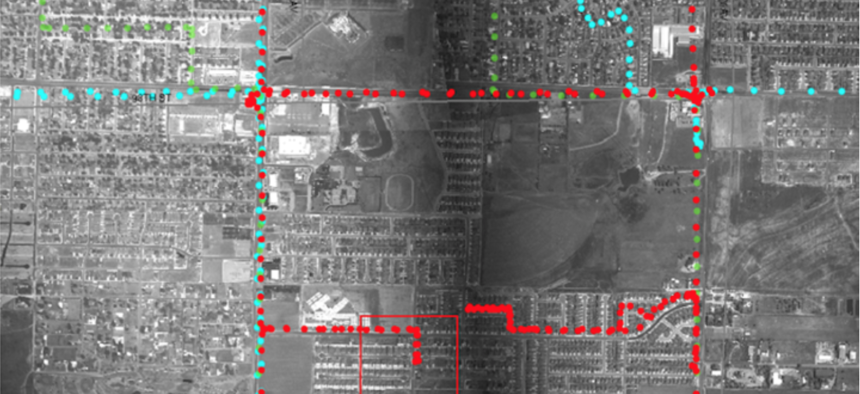
Aerial surveillance equipment is capable of tracking the paths of individual cars along residential streets. JOHN MARION / BLUEGRASS
Military-Style Surveillance Technology Is Being Tested in American Cities
In the eyes of the law, there’s no difference between a smartphone photo taken through an airplane window and one taken by an ultra-powerful camera in a helicopter hovering over your backyard.
Say you’re on a commercial flight and you pass over a city. You pull out your phone and take a picture. Much of the area that you have photographed is private property, but have you violated anybody’s privacy? You’d probably say no, and you’d be right. But what if, instead of your phone, you use a professional camera equipped with a telescopic lens that’s strong enough to make out individual people in their backyards? Though your actions might raise some eyebrows among your fellow passengers, they are, from a legal standpoint, no different from the first example.
Let’s say you take it a step further. You fly a helicopter over the city at 1,000 feet. Now, with your telescopic camera, you can even make out distinctive features of the people in your frame. Surely this isn’t legal, you might say. Surely a bright line exists between snapping a photo with your phone from an airplane window and focusing a telescopic lens a few hundred feet over someone’s backyard.
But it doesn’t. Even if you happen to record someone sunbathing in a backyard, it is not your fault. It’s the sunbather’s fault, for not taking better precautions to protect against aerial observation.
Related: Kentucky Is Turning to Drones to Fix Its Unsolved-Murder Crisis
Related: Police-Grade Surveillance Technology Comes to the Playground
Related: The Push to ‘Predict’ Police Shootings
This is because the airspace over America falls into the same legal category as other public spaces, such as sidewalks, roads, parks, and beaches—and it isn’t illegal to take photographs of private property, or private citizens, from public space. As a result, we have no expectation of privacy from above.
Even the most secretive organizations in the U.S. government are not necessarily safe from aerial observation. In the spring of 1998, an NSA employee who goes by the nickname Cheebie was standing in the parking lot of the agency’s headquarters, in Maryland, when a civilian helicopter equipped with a strange, round object under its nose flew directly overhead. A group of employees inside the building worried that the helicopter crew might have even been able to see into their offices through their open blinds.
As it turned out, the helicopter was being operated by a film crew working on—believe it or not—Enemy of the State. It was taking a series of establishing shots of the agency’s sleek glass complex. Cheebie and other employees asked the NSA administration whether the agency could have done anything to prevent the flight. They couldn’t. “Believe me,” wrote one public-relations official in response to the queries, “we tried.”
A few days earlier, members of the film’s production team had met with a group of NSA officials, and had explained that they were planning a series of flights over the facility in the following weeks. The officials protested the idea, but there was nothing they could do, legally speaking, to stand in the way. The airspace over the complex is public. All the Enemy of the State crew had to do was file a flight plan and call it a photo mission.
Capitalizing on this gap, as some might call it, in standing privacy law, wide-area-camera manufacturers and users often turn the all-seeing eye on peacetime populations in the United States and elsewhere without their knowledge. PV Labs, a Canadian firm, has flown a “persistent surveillance” camera over various U.S. cities, including Charlotte and Wilmington, North Carolina. The Australian Department of Defence has tested a wide-area camera in exercises over Adelaide and Montreal. The Air Force has spent hours recording Ohio State University’s campus in Columbus.
Related podcast:
Such flights continue to this day. In the summer of 2017, the Air Force 427th Special Operations Squadron’s top-secret WAMI airplane spent more than 50 hours flying orbits over Seattle, in some cases loitering over a single neighborhood (Bellevue and Renton were favorites) for four or five hours at a time.
When it comes to law enforcement, police are likewise free to use aerial surveillance without a warrant or special permission. Under current privacy law, these operations are just as legal as policing practices whereby an officer spots unlawful activity while walking or driving through a neighborhood. Say an officer sees marijuana plants through the open window of a house. Because the officer is in a public space—a road or sidewalk—he or she doesn’t need permission to see the illicit plants, or a warrant to photograph the scene.
The only caveat to police aerial-surveillance activities is that they must employ publicly accessible technology, a term that has been defined, somewhat vaguely, in a small number of court cases. In two cases from the 1980s stemming from investigations in which police used cameras aboard helicopters to spot marijuana plants, the Supreme Court ruled that the law-enforcement agencies had not violated the Fourth Amendment, because both helicopters and commercial cameras are generally publicly available (if not exactly affordable).
In another case, Kyllo v. United States, in which police looking for indoor marijuana plants pointed an infrared camera at the plaintiff’s garage from a public vantage point, the Court ruled that the police’s actions constituted a warrantless search, because an infrared camera did not constitute a publicly available technology.
The courts have yet to rule on which side of the “publicly accessible” divide a camera capable of watching a whole city at once would fall. So far, no law-enforcement agency using WAMI has faced a legal challenge.
NEXT STORY: Esper Puts JEDI Contract on Hold for Review